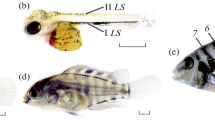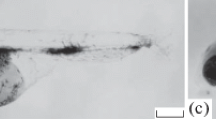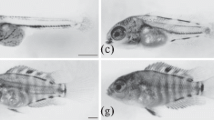Abstract
Male guppies display an outstanding diversity of color patterns which is formed as a result of a complex interplay between sexual selection, predation, and other environmental factors. The heterogeneity of the environment affects the variability of ornamental traits in male guppies through genotype–environment interaction. Thyroid hormones (THs) are important regulators of the ontogeny of fish and serve as a link between environmental changes and phenotypic development. However, the role of THs in the formation of a variety of color patterns in male guppies remained poorly understood. In this work, an experimental assessment of the effect of THs on the variability of ornamental traits in Poecilia wingei males was carried out. The fish were reared from birth to the initial stages of the formation of melanistic elements in males and until the final formation of the color pattern; they were subjected to different hormonal regimes: euthyroidism (natural TH status), hyperthyroidism (high TH level, at a triiodo-L-thyronine concentration of 0.15 μg/mL), and hypothyroidism (TH-deficiency, at a thiourea concentration of 0.025%). Alterations in the TH status caused changes in the timing and rate of the development of coloration and affected the transformation of various elements of the color pattern in males. These changes led to an increase in phenotypic variability and the appearance of ornamental traits in the male color patterns that were characteristic of closely related species of Poecilia. Thus, the data obtained indicate a potentially important role of thyroid hormones in the diversification of guppy color patterns and open up new prospects for studying the role of endocrine regulatory mechanisms in the adaptive evolution of poeciliid fish.







Similar content being viewed by others
References
Alexander HJ, Breden F (2004) Sexual isolation and extreme morphological divergence in the Cumana guppy: a possible case of incipient speciation. J Evol Biol 17:1238–1254
Brooks R, Endler JA (2001) Direct and indirect sexual selection and quantitative genetics of male traits in guppies (Poecilia reticulata). Evol 55:1002–1015
Brown DD (1997) The role of thyroid hormone in zebrafish and axolotl development. Proc Natl Acad Sci 94(24):13011-13016. https://doi.org/10.1073/pnas.94.24.13011
Clement SE, Lichtenbert JH, Kohler CC (2001) Stripping clowns: induced meristic changes in common clownfish (Amphiprion ocellaris). Bull Inst Océanogr Monaco 20:283–288
Dick C, Arendt J, Reznick DN, Hayashi CY (2018) The developmental and genetic trajectory of coloration in the guppy (Poecilia reticulata). Evol Dev 20:207–218. https://doi.org/10.1111/ede.12268
Eales JG, Chang JP, Van Der Kraak G, Omeljaniuk RJ, Uin L (1982) Effects of temperature on plasma thyroxine and lodide kinetics in rainbow trout, Salmo gairdneri. Gen Сomp Endocrin 47:295–307
Endler JA (1980) Natural selection on color patterns in Poecilia reticulata. Evol 34:76–91
Endler JA (1984) Natural and sexual selection on color patterns in poeciliid fishes. In: Zarct TM (ed) Evolutionary ecology of neotropical freshwater fishes. Springer, Dordrecht, pp 95–111
Endler JA (1995) Multiple-trait coevolution and environmental gradients in guppies. Trends Ecol Evol 10:22–29
Eom DS, Bain EJ, Patterson LB, Grout ME, Parichy DM (2015) Long-distance communication by specialized cellular projections during pigment pattern development and evolution. Elife. 4. https://doi.org/10.7554/eLife.12401
Eskova A, Frohnhöfer HG, Nüsslein-Volhard C, Irion U (2020) Galanin signaling in the brain regulates color pattern formation in zebrafish. Curr Biol 30:298–303. https://doi.org/10.1016/j.cub.2019.11.033
Fadeev A, Krauss J, Frohnhöfer HG, Irion U, Nüsslein-Volhard C (2015) Tight junction protein 1a regulates pigment cell organisation during zebrafish colour patterning. Elife. 4. https://doi.org/10.7554/eLife.06545
Frohnhöfer HG, Krauss J, Maischein HM, Nüsslein-Volhard C (2013) Iridophores and their interactions with other chromatophores are required for stripe formation in zebrafish. Devel 140:2997–3007. https://doi.org/10.1242/dev.096719
Grether GF, Hudon J, Millie DF (1999) Carotenoid limitation of sexual coloration along an environmental gradient in guppies. Proc R Soc Lond B Biol Sci 266:1317–1322. https://doi.org/10.1098/rspb.1999.0781
Grether GF, Hudon J, Endler JA (2001) Carotenoid scarcity, synthetic pteridine pigments and the evolution of sexual coloration in guppies (Poecilia reticulata). Proc R Soc Lond B Biol Sci 268:1245–1253. https://doi.org/10.1098/rspb.2001.1624
Grether GF, Cummings ME, Hudon J (2005) Countergradient variation in the sexual coloration of guppies (Poecilia reticulata): drosopterin synthesis balances carotenoid availability. Evol 59:175–188. https://doi.org/10.1111/j.0014-3820.2005.tb00904.x
Guillot R, Muriach B, Rocha A, Rotllant J, Kelsh RN, Cerdá-Reverter JM (2016) Thyroid hormones regulate zebrafish melanogenesis in a gender-specific manner. PLoS One 11:e0166152. https://doi.org/10.1371/journal.pone.0166152
Hamada H, Watanabe M, Lau HE, Nishida T, Hasegawa T, Parichy DM, Kondo S (2014) Involvement of Delta/notch signaling in zebrafish adult pigment stripe patterning. Devel 141:318–324. https://doi.org/10.1242/dev.099804
Holzer G, Laudet V (2015) Thyroid hormones: a triple-edged sword for life history transitions. Curr Biol 25:344–347. https://doi.org/10.1016/j.cub.2015.02.026
Houde AE (1992) Sex-linked heritability of a sexually selected character in a natural population of Poecilia reticulata (Pisces: Poeciliidae) (guppies). Heredity 69:229–235
Houde AE (1997) Sex, color, and mate choice in guppies. Princeton Univ, Press, Princeton, NJ
Hughes KA, Rodd FH, Reznick DN (2005) Genetic and environmental effects on secondary sex traits in guppies (Poecilia reticulata). J Evol Biol 18:35–45. https://doi.org/10.1111/j.1420-9101.2004.00806.x
Hughes KA, Houde AE, Price AC, Rodd FH (2013) Mating advantage for rare males in wild guppy populations. Nat 503:108–110. https://doi.org/10.1038/nature12717
Karagic N, Härer A, Meyer A, Torres-Dowdall J (2018) Heterochronic opsin expression due to early light deprivation results in drastically shifted visual sensitivity in a cichlid fish: possible role of thyroid hormone signaling. J Exper Zool Part B: Mol and Devel Evol 330:202–214. https://doi.org/10.1002/jez.b.22806
Karino K, Shinjo S (2004) Female mate preference based on male orange spot patterns in the feral guppy Poecilia reticulata in Japan. Ichthyol Res 51:316–320. https://doi.org/10.1007/s10228-004-0234-6
Kemp DJ, Reznick DN, Grether GF, Endler JA (2009) Predicting the direction of ornament evolution in Trinidadian guppies (Poecilia reticulata). Proc R Soc B Biol Sci 276:4335–4343. https://doi.org/10.1098/rspb.2009.1226
Kemp DJ, Batistic FK, Reznick DN (2018) Predictable adaptive trajectories of sexual coloration in the wild: evidence from replicate experimental guppy populations. Evol 72:2462–2477. https://doi.org/10.1111/evo.13564
Kitano J, Lema SC, Luckenbach JA, Mori S, Kawagishi Y, Kusakabe M, Swanson P, Peichel CL (2010) Adaptive divergence in the thyroid hormone signaling pathway in the stickleback radiation. Curr Biol 20:2124–2130. https://doi.org/10.1016/j.cub.2010.10.050
Kodric-Brown A (1989) Dietary carotenoids and male mating success in the guppy: an environmental component to female choice. Behav Ecol Sociobiol 25:393–401
Kolluru GR (2014) Genotype by environment interactions and sexual selection in guppies. In: Hunt J, Hosken D (eds) Genotype by environment interactions and sexual selection. Wiley, NJ, pp 282–311
Kottler VA, Schartl M (2018) The colorful sex chromosomes of teleost fish. Genes 9:233. https://doi.org/10.3390/genes9050233
Kottler VA, Fadeev A, Weigel D, Dreyer C (2013) Pigment pattern formation in the guppy, Poecilia reticulata, involves the Kita and Csf1ra receptor tyrosine kinases. Genet 194:631–646. https://doi.org/10.1534/genetics.113.151738
Kottler VA, Koch I, Flötenmeyer M, Hashimoto H, Weigel D, Dreyer C (2014) Multiple pigment cell types contribute to the black, blue, and orange ornaments of male guppies (Poecilia reticulata). PLoS One 9:e85647. https://doi.org/10.1371/journal.pone.0085647
Krauss J, Frohnhöfer HG, Walderich B, Maischein HM, Weiler C, Irion U, Nüsslein-Volhard C (2014) Endothelin signalling in iridophore development and stripe pattern formation of zebrafish. Biol Open 3:503–509. https://doi.org/10.1242/bio.20148441
Leiner KA, Mackenzie DS (2003) Central regulation of thyroidal status in a teleost fish: Nutrient stimulation of T4 secretion and negative feedback of T3. J Exper Zool Part A: Compar Exper Biol 298(1):32-43. https://doi.org/10.1002/jez.a.10255
Lema SC (2014) Hormones and phenotypic plasticity in an ecological context: linking physiological mechanisms to evolutionary processes. Integr Comp Biol 54:850–863. https://doi.org/10.1093/icb/icu019
Lema SC (2020) Hormones, developmental plasticity, and adaptive evolution: endocrine flexibility as a catalyst for ‘plasticity-first’phenotypic divergence. Mol Cell Endocrinol 502:110678. https://doi.org/10.1016/j.mce.2019.110678
Lema SC, Kitano J (2013) Hormones and phenotypic plasticity: implications for the evolution of integrated adaptive phenotypes. Curr Zool 59:506–525. https://doi.org/10.1093/czoolo/59.4.506
Levis NA, Pfennig DW (2016) Evaluating ‘plasticity-first’evolution in nature: key criteria and empirical approaches. Trends Ecol Evol 31:563–574. https://doi.org/10.1016/j.tree.2016.03.012
Magurran AE (2005) Evolutionary ecology: the Trinidadian guppy. Oxford University Press on Demand
Mahalwar P, Singh AP, Fadeev A, Nüsslein-Volhard C, Irion U (2016) Heterotypic interactions regulate cell shape and density during color pattern formation in zebrafish. Biol Open 5:1680–1690. https://doi.org/10.1242/bio.022251
McMenamin SK, Bain EJ, McCann AE et al (2014) Thyroid hormone–dependent adult pigment cell lineage and pattern in zebrafish. Science 345:1358–1361. https://doi.org/10.1126/science.1256251
Millar NP, Reznick DN, Kinnison MT, Hendry AP (2006) Disentangling the selective factors that act on male colour in wild guppies. Oikas 113:1–12. https://doi.org/10.1111/j.0030-1299.2006.14038.x
Müller GB (2007) Evo-devo: extending the evolutionary synthesis. Nat Rev Genet 8:943–949. https://doi.org/10.1038/nrg2219
Olendorf R, Rodd FH, Punzalan D, Houde AE, Hurt C, Reznick DN, Hughes KA (2006) Frequency-dependent survival in natural guppy populations. Nat 441:633–636. https://doi.org/10.1038/nature04646
O'Steen S, Cullum AJ, Bennett AF (2002) Rapid evolution of escape ability in Trinidadian guppies (Poecilia reticulata). Evol 56:776–784. https://doi.org/10.1111/j.0014-3820.2002.tb01388.x
Owen JP, Kelsh RN, Yates CA (2020) A quantitative modelling approach to zebrafish pigment pattern formation. Elife 9:e52998. https://doi.org/10.7554/eLife.52998
Parichy DM, Spiewak JE (2015) Origins of adult pigmentation: diversity in pigment stem cell lineages and implications for pattern evolution. Pigment Cell Melanoma Res 28:31–50. https://doi.org/10.1111/pcmr.12332
Patterson LB, Parichy DM (2013) Interactions with iridophores and the tissue environment required for patterning melanophores and xanthophores during zebrafish adult pigment stripe formation. PLoS Genet 9:e1003561. https://doi.org/10.1371/journal.pgen.1003561
Patterson LB, Parichy DM (2019) Zebrafish pigment pattern formation: insights into the development and evolution of adult form. Annu Rev Genet 53:505–530. https://doi.org/10.1146/annurev-genet-112618-043741
Poeser FN, Kempkes M, Isbrücker IJ (2005) Description of Poecilia (Acanthophacelus) wingei n. sp. from the Paría peninsula, Venezuela, including notes on Acanthophacelus Eigenmann, 1907 and other subgenera of Poecilia Bloch and Schneider, 1801 (Teleostei, Cyprinodontiformes, Poeciliidae). Contrib Zool 74:97–115. https://doi.org/10.1163/18759866-0740102007
Prazdnikov DV (2020) Effect of thyroid hormones on the development of asymmetric pigment patterns in teleost fish: experimental data on the example of Amatitlania nigrofasciata (Cichlidae) and Poecilia wingei (Poeciliidae). Biol Bull 47:198–204. https://doi.org/10.1134/S1062359020020065
Prazdnikov DV, Shkil FN (2019a) Experimental evidence of the role of heterochrony in evolution of the Mesoamerican cichlids pigment patterns. Evol Dev 21:3–15. https://doi.org/10.1111/ede.12272
Prazdnikov DV, Shkil FN (2019b) The experimental heterochronies in a green terror cichlid Andinoacara rivulatus (Teleostei: Cichlidae: Cichlasomatinae) indicate a role of developmental changes in the cichlids coloration evolution. Biol Bull 46:56–64. https://doi.org/10.1134/S1062359019010102
Rahman MM, Kelley JL, Evans JP (2013) Condition dependent expression of pre- and postcopulatory sexual traits in guppies. Ecol Evol 3:2197–2213. https://doi.org/10.1002/ece3.632
Řežucha R, Reichard M (2015) Strategic exploitation of fluctuating asymmetry in male Endler's guppy courtship displays is modulated by social environment. J Evol Biol 28:356–367. https://doi.org/10.5061/dryad.9hk3g
Ruell EW, Handelsman CA, Hawkins CL, Sofaer HR, Ghalambor CK, Angeloni L (2013) Fear, food and sexual ornamentation: plasticity of colour development in Trinidadian guppies. Proc R Soc B Biol Sci 280:20122019. https://doi.org/10.1098/rspb.2012.2019
Saunders LM, Mishra AK, Aman AJ, Lewis VM, Toomey MB, Packer JS, Qiu X, McFaline-Figueroa JL, Corbo JC, Trapnell C, Parichy DM (2019) Thyroid hormone regulates distinct paths to maturation in pigment cell lineages. Elife 8:e45181. https://doi.org/10.7554/eLife.45181
Schindelin J, Arganda-Carreras I, Frise E, Kaynig V, Longair M, Pietzsch T, Preibisch S, Rueden C, Saalfeld S, Schmid B, Tinevez JY, White DJ, Hartenstein V, Eliceiri K, Tomancak P, Cardona A (2012) Fiji: an open-source platform for biological-image analysis. Nat Methods 9:676–682. https://doi.org/10.1038/nmeth.2019
Schories S, Meyer MK, Schartl M (2009) Description of Poecilia (Acanthophacelus) obscura n. sp.,(Teleostei: Poeciliidae), a new guppy species from western Trinidad, with remarks on P. wingei and the status of the Endler s guppy. Zootaxa 2266:35–50
Schwartz AK, Hendry AP (2010) Testing the influence of local forest canopy clearing on phenotypic variation in Trinidadian guppies. Funct Ecol 24:354–364. https://doi.org/10.1111/j.1365-2435.2009.01652.x
Shenoy K (2012) Environmentally realistic exposure to the herbicide atrazine alters some sexually selected traits in male guppies. PLoS One 7:e30611. https://doi.org/10.1371/journal.pone.0030611
Shenoy K, Crowley PH (2011) Endocrine disruption of male mating signals: ecological and evolutionary implications. Funct Ecol 25:433–448. https://doi.org/10.1111/j.1365-2435.2010.01787.x
Shkil FN, Kapitanova DV, Borisov VB, Abdissa B, Smirnov SV (2012) Thyroid hormone in skeletal development of cyprinids: effects and morphological consequences. Journal of Applied Ichthyology 28:398–405. https://doi.org/10.1111/j.1439-0426.2012.01992.x
Shkil FN, Smirnov SV (2015) Experimental approach to the hypotheses of heterochronic evolution in lower vertebrates. Paleontol J 49:1624–1634. https://doi.org/10.1134/S0031030115140178
Singh AP (2015) Nüsslein-Volhard C. Zebrafish stripes as a model for vertebrate colour pattern formation Curr Biol 25:R81–R92. https://doi.org/10.1016/j.cub.2014.11.013
Tripathi N, Hoffmann M, Dreyer C (2008) Natural variation of male ornamental traits of the guppy, Poecilia reticulata. Zebrafish 5:265–278. https://doi.org/10.1089/zeb.2008.0548
Tripathi N, Hoffmann M, Willing EM, Lanz C, Weigel D, Dreyer C (2009) Genetic linkage map of the guppy, Poecilia reticulata, and quantitative trait loci analysis of male size and colour variation. Proc R Soc B Biol Sci 276:2195–2208. https://doi.org/10.1098/rspb.2008.1930
Valvo JJ, Rodd FH, Hughes KA (2019) Consistent female preference for rare and unfamiliar male color patterns in wild guppy populations. Behav Ecol 30:1672–1681. https://doi.org/10.1093/beheco/arz134
Watanabe M, Kondo S (2015) Is pigment patterning in fish skin determined by the Turing mechanism? Trends Genet 31:88–96. https://doi.org/10.1016/j.tig.2014.11.005
Weese DJ, Gordon SP, Hendry AP, Kinnison MT (2010) Spatiotemporal variation in linear natural selection on body color in wild guppies (Poecilia reticulata). Evol: Intern J Organ Evol 64:1802–1815. https://doi.org/10.1111/j.1558-5646.2010.00945.x
West-Eberhard MJ (2005) Phenotypic accommodation: adaptive innovation due to developmental plasticity. J of Experl Zool Part B: Mol Devel Evol 304:610–618. https://doi.org/10.1002/jez.b.21071
Yoo JH, Takeuchi T, Tagawa M, Seikai T (2000) Effect of thyroid hormones on the stage-specific pigmentation of the Japanese flounder Paralichthys olivaceus. Zool Sci 17:1101–1106. https://doi.org/10.2108/zsj.17.1101
Zak MA, Manzon RG (2019) Expression and activity of lipid and oxidative metabolism enzymes following elevated temperature exposure and thyroid hormone manipulation in juvenile lake whitefish (Coregonus clupeaformis). Gener Comp Endocrin 275:51–64. https://doi.org/10.1016/j.ygcen.2019.02.001
Acknowledgments
I am grateful to anonymous reviewers for their valuable comments and suggestions. This study was partially supported by the Russian Foundation for Basic Research, project no. 18-34-00685.
Availability of data and material
The datasets generated during the current study are available on reasonable request.
Code availability
Not applicable.
Author information
Authors and Affiliations
Corresponding author
Ethics declarations
Conflict of interest
The author declares no competing interest.
Ethics approval
All experimental procedures with fish were carried out according to the guidelines and following the laws and ethics of the Russian Federation and approved by the ethics committee of the Severtsov Institute of Ecology and Evolution, Russian Academy of Sciences (Moscow).
Additional information
Publisher’s note
Springer Nature remains neutral with regard to jurisdictional claims in published maps and institutional affiliations.
Rights and permissions
About this article
Cite this article
Prazdnikov, D.V. Role of thyroid hormones in color diversity of male guppies: experimental data on Endler’s guppy (Poecilia wingei). Environ Biol Fish 104, 675–688 (2021). https://doi.org/10.1007/s10641-021-01102-x
Received:
Accepted:
Published:
Issue Date:
DOI: https://doi.org/10.1007/s10641-021-01102-x




